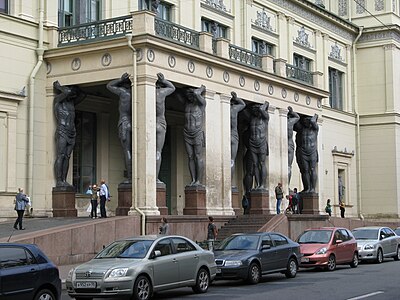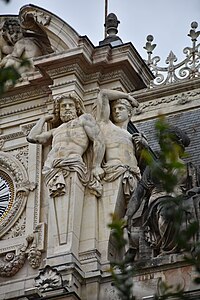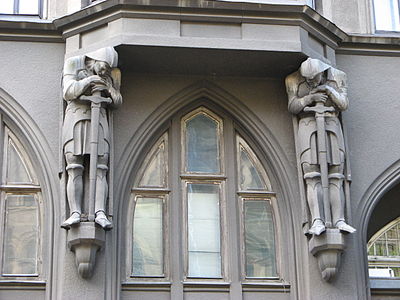Atlas (architecture)



In European architectural sculpture, an atlas (also known as an atlant, or atlante[1] or atlantid; plural atlantes)[2] is a support sculpted in the form of a man, which may take the place of a column, a pier or a pilaster. The Roman term for such a sculptural support is telamon (plural telamones or telamons).[2]
The term atlantes is the Greek plural of the name Atlas—the Titan who was forced to hold the sky on his shoulders for eternity. The alternative term, telamones, also is derived from a later mythological hero, Telamon, one of the Argonauts, who was the father of Ajax.
The caryatid is the female precursor of this architectural form in Greece, a woman standing in the place of each column or pillar. Caryatids are found at the treasuries at Delphi and the Erechtheion on the Acropolis at Athens for Athene. They usually are in an Ionic context and represented a ritual association with the goddesses worshiped within.[3] The Atlante is typically life-size or larger; smaller similar figures in the decorative arts are called terms. The body of many Atlantes turns into a rectangular pillar or other architectural feature around the waist level, a feature borrowed from the term. The pose and expression of Atlantes very often show their effort to bear the heavy load of the building, which is rarely the case with terms and caryatids. The herma or herm is a classical boundary marker or wayside monument to a god which is usually a square pillar with only a carved head on top, about life-size, and male genitals at the appropriate mid-point. Figures that are rightly called Atlantes may sometimes be described as herms.
Atlantes express extreme effort in their function, heads bent forward to support the weight of the structure above them across their shoulders, forearms often lifted to provide additional support, providing an architectural motif. Atlantes and caryatids were noted by the Roman late Republican architect Vitruvius, whose description of the structures,[4] rather than surviving examples, transmitted the idea of atlantes to the Renaissance architectural vocabulary.
Origin
[edit]Not only did the Caryatids precede them, but similar architectural figures already had been made in ancient Egypt out of monoliths. Atlantes originated in Greek Sicily and in Magna Graecia, Southern Italy. The earliest surviving atlantes are fallen ones from the Early Classical Greek temple of Zeus, the Olympeion, in Agrigento, Sicily.[5] Atlantes also played a significant role in Mannerist and Baroque architecture.
During the eighteenth and nineteenth centuries, the designs of many buildings featured glorious atlantes that looked much like Greek originals. Their inclusion in the final design for the portico of the Hermitage Museum in St. Petersburg that was built for Tsar Nicholas I of Russia in the 1840’s made the use of atlantes especially fashionable. The Hermitage portico incorporates ten enormous atlantes, approximately three times life-size, carved from Serdobol granite, which were designed by Johann Halbig and executed by the sculptor Alexander Terebenev.
Mesoamerica
[edit]Similar carved stone columns or pillars in the shape of fierce men at some sites of Pre-Columbian Mesoamerica are typically called Atlantean figures. These figures are considered to be "massive statues of Toltec warriors".[6]
Examples
[edit]- Basilica di Santa Croce, Lecce, Italy
- Casa degli Omenoni, Milan, Italy
- Church of St. Georg, Hamburg, Germany
- Dům U Čtyř mamlasů, Brno, Czech Republic
- Hermitage Museum, St. Petersburg, Russia
- House in Kanałowa Str. 17, Poznań, Poland
- Palazzo Davia Bargellini, Bologna, Italy
- Pavilion Vendôme, Aix-en-Provence, France
- Porta Nuova, Palermo, Italy
- Sanssouci, Potsdam, Germany
- Sunshine Marketplace, Victoria, Australia
- Temple of Olympian Zeus, Valle dei Templi, Agrigento, Italy
- Tyszkiewicz Palace, Warsaw, Poland
- Zwinger Palace, Germany
- Wayne County Courthouse, Wooster, Ohio, United States
Gallery
[edit]-
Sumerian façade of the Inanna Temple of Karaindash, Uruk, c.1413 BC, overall height: 211 cm, Vorderasiatisches Museum Berlin, Germany
-
First Pillared Hall, with eight Osiride statues of Ramsses II, Temple of Ramsses II, Abu Simbel, Egypt, 13th century BC
-
Model of Ancient Greek, Temple of Olympian Zeus, Agrigento, Sicily, original 5th century BC, Agrigento museum
-
Ancient Greek atlas from the Temple of Olympian Zeus, Agrigento, 5th century BC, Agrigento Museum
-
Maya kneeling atlas, 900-1250, limestone, Musée du Quai Branly, Paris
-
Romanesque atlantes in chains at Oloron Cathedral, France, 12th century
-
Gothic atlas on Laon Cathedral, France, 12th-13th centuries
-
Renaissance atlantes in the courtyard of the Palazzo del Te, in the suburbs of Mantua, Italy, designed by Giulio Romano, 1524–1534
-
Renaissance atlantes in the courtyard of the Maison Maillard, Dijon, France, attributed to Hugues Sambin, 1561
-
Renaissance fireplace with atlantes in the ballroom of the Palace of Fontainebleau, France, unknown architect, unknown date
-
Mannerist atlantes of the Santuario della Beata Vergine dei Miracoli, Saronno, Italy, designed by Pellegrino Tibaldi, 1596-1613
-
Baroque designs of caryatids (left) and atlantes (right), each symbolizing a season of the year, by Jean Le Pautre, c.1670–1680, etching on paper
-
Baroque atlantes of an armchair, by Andrea Brustolon, c.1700-1715, wood and upholstery, Ca' Rezzonico, Venice
-
Rococo atlantes in the Schleissheim Palace, Munich, Germany, probably by Joseph Effner, early 18th century
-
Chinoiserie atlas of the Japanisches Palais, Dresden, Germany, designed by Matthäus Daniel Pöppelmann, Zacharias Longuelune or Jean de Bodt, 1715-1731
-
Louis XVI style altantes on a commode, by Jean-Henri Riesener, 1775, gilt brone, marble top, and various types of wood, Musée Condé, Chantilly, France[11]
-
Neoclassical atlantes of the New Hermitage, Saint-Petersburg, Russia, designed by Leo von Klenze and sculpted by Alexandre Terebeniov, 1842—1851
-
Rococo Revival atlantes on the facade of the Beloselsky-Belozersky Palace, Saint Petersburg, designed by Andrei Stackenschneider, 1847-1848
-
Baroque Revival atlantes of the Palais de la Bourse, Lyon, France, designed by René Dardel and sculpted by Jean-Marie Bonnassieux, 1854-1860
-
Neoclassical atlas of Mercury and a caryatid of Minerva of Rue Édouard-Herriot no. 39, Lyon, sculpted by Joseph-Hugues Fabisch, 1863
-
Neoclassical atlantes of Place d'Estienne-d'Orves no. 2, Paris, sculptor Joseph Caillé and architect Ch. Forest, 1866
-
Second Empire style Atlantid at the Wayne County Courthouse, Wooster, Ohio, United States. Unknown sculptor, architect Thomas Boyd, circa 1887-89.
-
Gothic Revival angel atlantes on the Cathedral of Saint Peter of Alcantara, Petrópolis, Brazil, designed by Francisco Caminhoá, 1884–1925
-
Beaux Arts atlantes at a monumental entrance in Paris, unknown architect and sculptor, c.1900
-
Rococo Revival atlantes of Siebensterngasse no. 4-6, Vienna, Austria, unknown architect and sculptor, c.1900
-
Beaux Arts atlantes of Rue de Rivoli no. 45, Paris, designed by A. Garriguenc, 1905
-
Gothic Revival atlantes on Kniazia Romana Street no. 6, Lviv, Ukraine, designed by Adolf Piller and Roman Volpel, 1913
-
Art Deco atlantes of the Grave of the Străjescu Family in the Bellu Cemetery, Bucharest, Romania, by George Cristinel, 1934[13]
-
Postmodern atlantes of the Florence de Voldère art gallery (Avenue Matignon no. 34), Paris, Jean-Jacques Fernier, 1998[14]
See also
[edit]References
[edit]- ^ Hersey, George, The Lost Meaning of Classical Architecture, MIT Press, Cambridge, MA, 1998 p. 129
- ^ a b Aru-Az' Archived 2008-07-04 at the Wayback Machine, Michael Delahunt, ArtLex Art Dictionary Archived 2005-04-24 at the Wayback Machine, 1996–2008.
- ^ Harris, Cyril M., ed., Illustrated Dictionary of Historic Architecture, Dover Publications, New York, 1983.
- ^ Vitruvius, De Architectura, 6.7.6.
- ^ "Dorothy King, "Doric Figured Supports: Vitruvius' Caryatids and Atlantes: 5.2 Atlantes and Telamones"".[permanent dead link]
- ^ Evans, Susan (2008). Ancient Mexico and Central America: Archaeology and Culture History. London: Thames & Hudson Ltd. p. 42.
- ^ Robertson, Jean; Hutton, Deborah (2022). The History of Art: A Global View: Prehistory to the Present. Thames & Hudson. p. 505. ISBN 978-0-500-02236-8.
- ^ Hall, William (2019). Stone. Phaidon. p. 185. ISBN 978-0-7148-7925-3.
- ^ Irving, Mark (2019). 1001 Buildings You Must See Before You Die. Cassel Illustrated. p. 215. ISBN 978-1-78840-176-0.
- ^ Irving, Mark (2019). 1001 Buildings You Must See Before You Die. Cassel Illustrated. p. 217. ISBN 978-1-78840-176-0.
- ^ Droth, Martina; Sheriff, Mary D.; Scott, Katie; Hellman, Mimi; Bremer-David, Charissa (2009). Taking Shape - finding sculpture in the decorative arts. The Henry Moore Foundation. p. 192. ISBN 978-1-905462-21-6.
- ^ "Café Bibent". pop.culture.gouv.fr. Retrieved 28 November 2023.
- ^ Criticos, Mihaela (2009). Art Deco sau Modernismul Bine Temperat - Art Deco or Well-Tempered Modernism (in Romanian and English). SIMETRIA. p. 79. ISBN 978-973-1872-03-2.
- ^ "34, avenue Matignon". www.pss-archi.eu. Retrieved 19 November 2023.
Bibliography
[edit]- King, Dorothy (1998). "Figured supports: Vitruvius' Caryatids and Atlantes". Quaderni Ticinesi. XXVII.[permanent dead link]
- Chisholm, Hugh, ed. (1911). . Encyclopædia Britannica. Vol. 26 (11th ed.). Cambridge University Press.





![Colossal Toltec atlantes, Tula, Hidalgo, Mexico, c.900–1100 AD, approximate height: 4.88 m[7]](http://upload.wikimedia.org/wikipedia/commons/thumb/f/f3/TulaSite81.JPG/453px-TulaSite81.JPG)






![Renaissance atlantes in the courtyard of the Maison Maillard [fr], Dijon, France, attributed to Hugues Sambin, 1561](http://upload.wikimedia.org/wikipedia/commons/thumb/c/c7/Dijon_geants.jpg/398px-Dijon_geants.jpg)







![Rococo atlas of the Zwinger, Dresden, Germany, designed by Matthäus Daniel Pöppelmann, 1719[8]](http://upload.wikimedia.org/wikipedia/commons/thumb/0/01/Dresden_Zwinger_Paul_Heermann_Nr_A7_06395_SHoppe2022.jpg/200px-Dresden_Zwinger_Paul_Heermann_Nr_A7_06395_SHoppe2022.jpg)
![Rococo atlantes at Sanssouci, Potsdam, Germany, by Georg Wenzeslaus von Knobelsdorff, 1748[9]](http://upload.wikimedia.org/wikipedia/commons/thumb/d/d6/Sans_Souci_2.jpg/400px-Sans_Souci_2.jpg)
![Rococo atlantes in the Cuvilliés Theatre, Munich, Germany, by François de Cuvilliés, 1751–1753[10]](http://upload.wikimedia.org/wikipedia/commons/thumb/1/10/M%C3%BCnchen-Altstadt_Cuvilli%C3%A9s-Theater_892.jpg/450px-M%C3%BCnchen-Altstadt_Cuvilli%C3%A9s-Theater_892.jpg)
![Louis XVI style altantes on a commode, by Jean-Henri Riesener, 1775, gilt brone, marble top, and various types of wood, Musée Condé, Chantilly, France[11]](http://upload.wikimedia.org/wikipedia/commons/thumb/b/b2/Ch%C3%A2teau_de_Chantilly-Petit_Cabinet-Commode-20120917..jpg/450px-Ch%C3%A2teau_de_Chantilly-Petit_Cabinet-Commode-20120917..jpg)










![Beaux Arts atlantes in the Café Bibent (Place du Capitole no. 5), Toulouse, France, 1900-1910[12]](http://upload.wikimedia.org/wikipedia/commons/thumb/b/b1/Le_Bibent_-_panoramio_%281%29.jpg/450px-Le_Bibent_-_panoramio_%281%29.jpg)


![Art Deco atlantes of the Grave of the Străjescu Family in the Bellu Cemetery, Bucharest, Romania, by George Cristinel, 1934[13]](http://upload.wikimedia.org/wikipedia/commons/thumb/7/7a/Grave_of_the_colonel_Paul_Str%C4%83jescu_Family_in_the_Bellu_Cemetery_in_Bucharest%2C_Romania_%2801%29.jpg/392px-Grave_of_the_colonel_Paul_Str%C4%83jescu_Family_in_the_Bellu_Cemetery_in_Bucharest%2C_Romania_%2801%29.jpg)
![Postmodern atlantes of the Florence de Voldère art gallery (Avenue Matignon no. 34), Paris, Jean-Jacques Fernier, 1998[14]](http://upload.wikimedia.org/wikipedia/commons/thumb/9/96/Galerie_de_Florence_de_Vold%C3%A8re_%C3%A0_Paris_2.JPG/400px-Galerie_de_Florence_de_Vold%C3%A8re_%C3%A0_Paris_2.JPG)